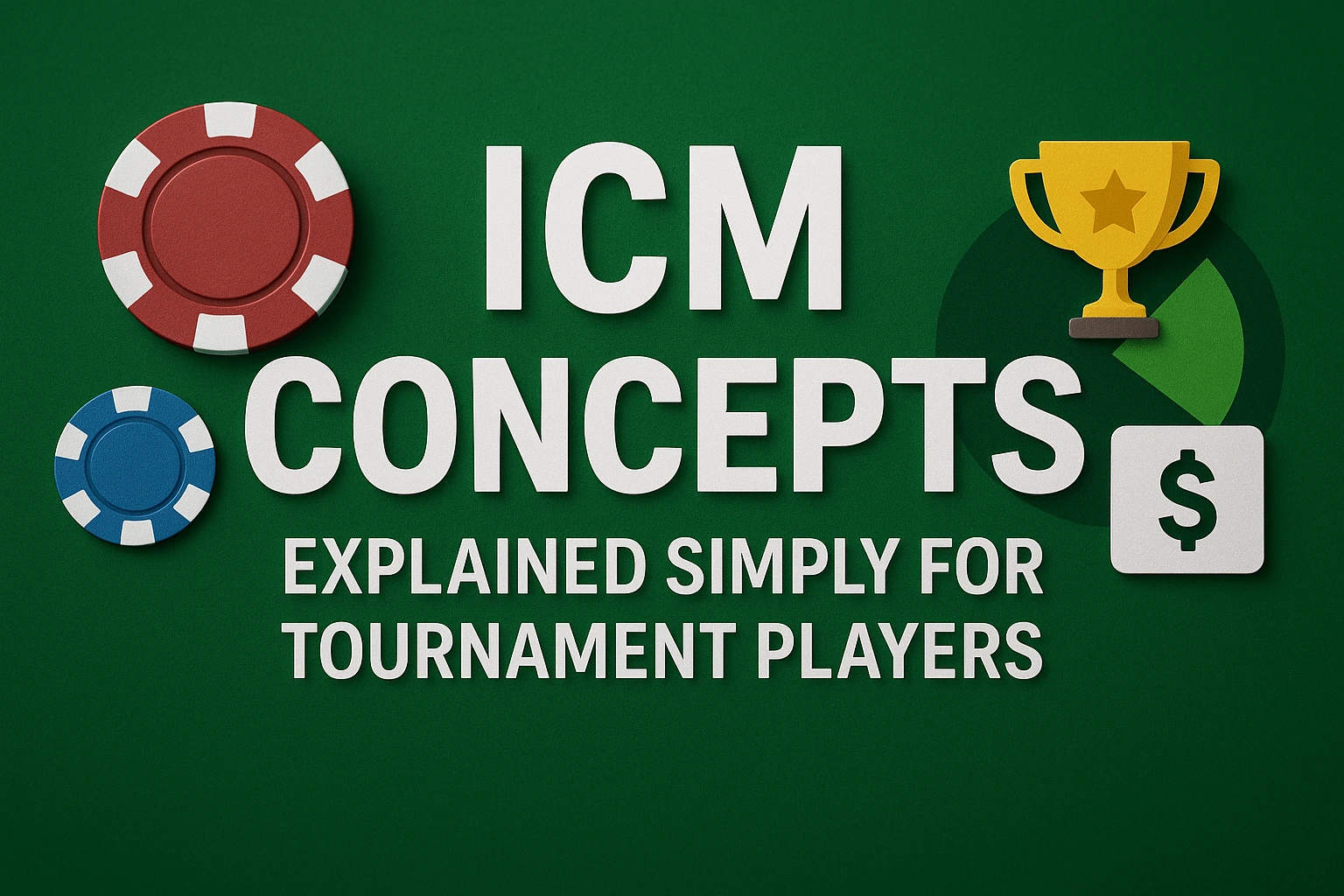
ICM Concepts can feel like a confusing puzzle when you first hear about them, but once you understand how they shape tournament decisions, the whole game suddenly makes more sense. Instead of thinking only about chip stacks, you start seeing how each decision affects your overall chances of surviving longer, climbing the leaderboard, and securing better placements. And honestly? Once these ideas click, your endgame sharpens instantly.
This guide breaks down ICM in a smooth, no-fluff style so you can apply it confidently at the tables. Along the way, you’ll get a simplified look at survival pressure, stack-value shifts, and how to use tools like an ICM poker calculator and an ICM poker chart to support your decisions.
Let’s get right into it.
Why ICM Concepts Matter in Tournament Play
In tournaments, every chip doesn’t hold the same value. Your decisions aren’t just about building a stack, they’re about protecting your placement, applying pressure at the right moment, and avoiding confrontations that jeopardize your survival.
ICM Concepts shape these decisions by showing how each additional pot influences your likelihood of moving up to higher finishing positions. It’s like a roadmap for identifying when aggression is profitable and when patience saves you from disaster.
Players who ignore ICM often bust earlier, while players who understand it make sharper, calmer, more controlled decisions at the most important stages. You can explore more competitive environments through our club list.
The Foundation of ICM Concepts Strategy
1. Chip Value Isn’t Linear
One common misunderstanding is thinking that doubling your chips doubles your chances of progressing deeper in the tournament. It doesn’t. Small stacks gain a lot from survival, medium stacks gain the most from picking spots, and big stacks control everything.
Here’s the breakdown:
- Short stacks gain huge value by surviving just one more elimination.
- Medium stacks must avoid unnecessary clashes because dropping too low creates major pressure.
- Big stacks gain powerful leverage, they can pressure everyone who wants to avoid losing placement.
Understanding this non-linear chip value is the core of ICM Concepts strategy.
2. Your Stack Size Controls Your Freedom
Depending on your stack category, your decisions shift dramatically:
Short Stacks
- Push/fold decisions carry serious placement consequences.
- Avoid marginal risks unless you’re forced to act.
- Look for fold equity, not big confrontations.
Medium Stacks
- You’re in the danger zone: you must protect your stack.
- Avoid battling with bigger stacks unnecessarily.
- Pick on smaller stacks instead, they feel the pressure more.
Big Stacks
- You get to apply maximum pressure.
- Target the medium stacks who cannot risk losing ground.
- Play aggressively in late position when others hesitate.
This dynamic alone can swing entire endings of tournaments.
Using Tools the Right Way
ICM Poker Calculator: Your Decision Coach
An ICM poker calculator helps you study whether pushing, calling, or folding in a certain spot improves your long-term tournament progression. You input stack sizes, positions, and players remaining. The tool then shows which option leads to better placement outcomes.
It doesn’t replace intuition, but it builds smart instincts, especially when refining your understanding of tournament progression.
ICM Poker Chart: Your Tournament Cheat Sheet
An ICM poker chart gives quick guidelines for push/fold decisions in high-pressure late-stage situations. It simplifies complex calculations into easy ranges, especially:
- Button shoves
- Small blind pushes
- Big blind calls
- Bubble or ladder spots
Using charts consistently helps reduce guesswork when the tension is high.
How ICM Shapes Real Tournament Decisions
1. Bubble Stage Awareness
When only a few players need to bust before you reach the next stage, survival becomes extremely valuable. This is where ICM dramatically changes your approach:
- Big stacks become hyper-aggressive.
- Medium stacks become defensive.
- Short stacks push only when they have fold equity or strong hands.
Sometimes folding a moderately strong hand is the correct play if it keeps you alive longer.
2. Final Table Pressure
At a final table, every elimination increases your finishing placement. ICM forces you to rethink every decision:
- A medium stack calling a big shove lightly can be disastrous.
- A big stack attacking medium stacks is almost always profitable.
- A short stack should shove wider when multiple medium stacks are scared to call.
Your goal isn’t just to win pots, it’s to navigate a path that maximizes advancement.
3. Avoiding Risky Coin Flips
A common mistake among inexperienced players is taking unnecessary coin flips late in tournaments. Even if you’re slightly ahead, losing the pot can ruin your chances of improving your position. ICM reminds you that:
- Survival > marginal chip gain
- Medium stack preservation > gambling
- Smart folds often outperform risky calls
Patience pays off here.
Simple ICM-Based Adjustments You Should Make
Here are some quick, actionable changes that instantly elevate your tournament game:
Be More Selective vs. Big Stacks
Big stacks have the freedom to apply maximum pressure because losing a pot doesn’t affect their placement as much as it affects yours. Under ICM, medium and short stacks simply cannot risk their tournament life casually, big stacks know this and use it to push players around.
What this means for you:
- Don’t take marginal spots against them.
- Avoid entering pots where you might be forced to fold later due to their aggression.
- Pick stronger, more stable hands before deciding to play back at them.
In short: you don’t want to be the one they push around, so tighten up and avoid giving them easy opportunities to dominate you.
Target Short Stacks Carefully
Short stacks are in survival mode. Every elimination helps them, so they’re selective with their spots. However, when they do shove, they often shove with hands that are stronger than you expect because they don’t want to make a mistake that ends their run.
How to adjust:
- Raising into short stacks is fine, they can’t respond lightly.
- But calling their all-ins too loosely is a mistake because their range is usually stronger than usual.
- You want to attack their blinds or steal when they’re likely to fold, not when they shove.
Under ICM pressure, short stacks are basically forced into “tight but desperate” decision-making. Exploit the fold spots, not the shove spots.
Avoid Clashing with Aggressive Medium Stacks
Medium stacks have the most to lose under ICM. If they slip too far down, they suddenly fall into the danger zone. If they go too hard against a big stack or lose a flip to a short stack, their entire tournament life becomes shaky.
Because of this, medium stacks often play a very careful, controlled game.
But here’s the twist:
Some medium stacks try to be overly aggressive to avoid falling behind.
Your job?
- Don’t get dragged into unnecessary battles with them, especially if they’re the second or third largest stack.
- They can hurt you more than you can hurt them.
- Instead, let them make mistakes by over-applying pressure elsewhere.
ICM says: if both stacks are similar in size, the risk isn’t worth the reward.
Don’t Over-Defend in Blind Battles
Blind battles feel tempting, “Hey, it’s only one other player, I can defend wide.”
But under ICM, defending too many hands from the blinds becomes dangerous because the post-flop mistakes cost you more than the chips you’re fighting for.
Why this happens:
- You are out of position.
- Your stack can be punished by aggressive players.
- Even medium pots can put your tournament stability at risk.
So the adjustment is simple:
- Tighten your defending range.
- Choose hands that play cleanly, good kickers, suited hands, pairs.
- Avoid junk that forces tough decisions on later streets.
Blind battles become high-pressure zones in late stages, so re-evaluating your ranges is crucial.
FAQs
What makes ICM different from normal strategy?
Normal strategy focuses on chip EV, while ICM focuses on improving your finishing position. It accounts for survival pressure and stack-value changes.
Should I rely only on an ICM poker calculator?
No. It’s a fantastic study tool, but you still need real-time judgment and table awareness.
Are ICM poker charts useful for beginners?
Absolutely. They simplify late-game situations and help you avoid common mistakes.
Why do big stacks get so aggressive under ICM?
Because other stacks can’t risk losing ground, giving the big stack extra leverage.
Do I apply ICM in early stages of tournaments?
Not really. ICM becomes most impactful near bubble stages, ladders, and final tables.
Conclusion
Mastering ICM Concepts strategy is one of the biggest leaps you can make as a tournament player. It teaches you when to protect your stack, when to apply pressure, and when survival is more important than chasing every pot. By understanding stack dynamics, using tools like an ICM poker calculator, reviewing an ICM poker chart, and learning how pressure shifts across stack sizes, you gain a complete edge in late-stage gameplay.
Tournament poker isn’t only about winning hands, it’s about choosing the right battles. And with ICM guiding those choices, you’ll find yourself advancing deeper, playing calmer under pressure, and making sharper, more disciplined decisions every time.
Start improving your game instantly by joining through our start playing page
